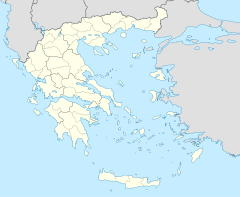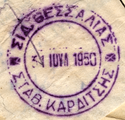railroad.wikisort.org - Station
Karditsa railway station (Greek: Σιδηροδρομικός σταθμός Καρδίτσας, romanized: Sidirodromikós stathmós Karditsa) is a railway station that serves the city of Karditsa, Thessaly, Greece.[3] Located 1.3 kilometres (0.81 mi) south of the centre of Karditsa, the station opened by the Thessaly Railways, (now part of OSE). Today TrainOSE operates 11 daily Regional trains[4] between Kalambaka, Athens, Thessaloniki, Larissa and Palaiofarsalos.[5]
This article uses bare URLs, which are uninformative and vulnerable to link rot. (June 2022) |
Καρδίτσας Karditsa | ||||||||||||||
|---|---|---|---|---|---|---|---|---|---|---|---|---|---|---|
 Karditsa station, May 2016 | ||||||||||||||
| General information | ||||||||||||||
| Location | 431 00, Karditsa Greece | |||||||||||||
| Coordinates | 39°21′14″N 21°54′53″E | |||||||||||||
| Owned by | GAIAOSE[1] | |||||||||||||
| Line(s) | Express Palaiofarsalos–Kalambaka railway[2] | |||||||||||||
| Platforms | 3 | |||||||||||||
| Tracks | 3 | |||||||||||||
| Train operators | Hellenic Train | |||||||||||||
| Construction | ||||||||||||||
| Structure type | at-grade | |||||||||||||
| Platform levels | 1 | |||||||||||||
| Parking | Yes | |||||||||||||
| Disabled access | ||||||||||||||
| Other information | ||||||||||||||
| Website | http://www.ose.gr/en/ | |||||||||||||
| History | ||||||||||||||
| Opened | 16 June 1886 | |||||||||||||
| Rebuilt | 2001 | |||||||||||||
| Electrified | No | |||||||||||||
| Services | ||||||||||||||
| ||||||||||||||
| Former service | ||||||||||||||
| ||||||||||||||
| Location | ||||||||||||||
 Karditsa Location within Greece | ||||||||||||||
 | ||||||||||||||
History
The station open 16 June 1886 by the Thessaly Railways.[6] The original station building (and the line) was designed by the Italian Evaristo de Chirico, (father of Giorgio de Chirico), however, this building was removed and replaced with a newer building some years later. The line was authorised by the Greek government under the law AMH’/22.6.1882.[7] soon after the liberation of Central Greece from the Ottomans.
After the First World War, the Greek state planned the ambitious construction of several new rail lines and links, including a standard gauge line from Kalambaka on to Kozani and then Veroia creating a conversion of the route from Volos to Kalambaka (though Karditsa) on standard gauge. In 1927, the relevant decisions were made; starting in 1928, work was carried out on the construction of the new line from Kalambaka. But a year later, it was clear that the project would exceed the estimated costs many times over. In 1932, the construction work was stopped and remains unfinished.[8] In 1955 Thessaly Railways was absorbed into Hellenic State Railways (SEK).[9]
Freight traffic declined sharply when the state-imposed monopoly of OSE for the transport of agricultural products and fertilisers ended in the early 1990s. Many small stations of the network with little passenger traffic were closed down, especially on the mainline section and between Karditsa and Kalampaka. In 2001 the section between Kalampaka and Palaiofarsalos was converted from Narrow gauge (1000 mm) to standard gauge (1435 mm) and physically connected at Palaiofarsalos with the mainline from Athens to Thessaloniki.[10] Since to upgrade; however, travel times improved and the unification of rail gauge allowed direct services, even InterCity services, to link Volos and Kalambaka with Athens and Thessaloniki.
In 2001 the infrastructure element of OSE was created, known as GAIAOSE; it would henceforth be responsible for the maintenance of stations, bridges and other elements of the network, as well as the leasing and the sale of railway assists.[11] In 2005, TrainOSE was created as a brand within OSE to concentrate on rail services and passenger interface. In 2009, with the Greek debt crisis unfolding OSE's Management was forced to reduce services across the network. Timetables were cut back and routes closed as the government-run entity attempted to reduce overheads. In 2015 a 15-year-old child was airlifted to hospital after being electrocuted at the station.[12] In 2017 OSE's passenger transport sector was privatised as TrainOSE; currently, a wholly-owned subsidiary of Ferrovie dello Stato Italiane[13] infrastructure, including stations, remained under the control of OSE. In July 2022, the station began being served by Hellenic Train, the rebranded TranOSE[14]
Facilities
The Station has waiting rooms on platform 1. There is a footbridge via stairs or lift from platform 1 to platform 2/3. The station is staffed, with ticket purchasing facilities and toilets, with Luggage storage available.
Services
The station is currently served by Regional trains between Athens, Thessaloniki, Larissa and Proastiakos, with up to six trains daily in each direction.[15]
Station layout
| Ground level | Customer service | Exit/Tickets |
| Level Ε1 |
Side platform, doors will open on the right | |
| Platform 1 | ||
| Platform 2 | ||
| Side platform, doors will open on the right/left | ||
| Platform 3 | Not in use | |
Gallery
 Karditsa train station stamp 1950
Karditsa train station stamp 1950- The station before its conversion to standard gauge September 1990
- The station approaches, looking east towards Sofades May 2016
External links
References
- "Home". gaiaose.com.
- "OSE - 2017 Network Statement Annexes".
- "Karditsa Station - National Railway Network - GTP".
- "Δρομολόγια ΤΡΑΙΝΟΣΕ".
- http://www.trainose.gr/wp-content/uploads/2014/03/%CE%A7%CE%B1%CF%81%CF%84%CE%B7%CF%82-%CE%94%CE%B9%CE%BA%CF%84%CF%85%CE%BF%CF%851.pdf [dead link]
- http://www.trainose.gr/en/ιστορικός-σταθμός-βόλου/ [dead link]
- "HistoryEN | Thessaly Museum Railways". thessalyrailways.gr. Archived from the original on 2020-07-28.
- Alexandros C. Gregoriou "The Kalambaka - Kozani - Veroia railway 1928 - 1932 (Kopie im Internet Archive)". Archived from the original on April 1, 2009. Retrieved August 8, 2020.
{{cite web}}: CS1 maint: bot: original URL status unknown (link) - "HistoryEN | Thessaly Museum Railways". thessalyrailways.gr. Archived from the original on 2020-07-28.
- "Upgrading of Paleofarsalos – Kalambaka line". ΕΡΓΟΣΕ. Retrieved 2019-01-03.
- "Home". gaiaose.com.
- http://www.alexandriamou.gr/ta-en-dimo-en-oiko/τραυματισμός-ατόμου-από-ηλεκτροπληξία-στο-σιδηροδρομικού-σταθμό-λεπτοκαρυάς-πιερίας.html [bare URL]
- "It's a new day for TRAINOSE as FS acquires the entirety of the company's shares". ypodomes.com. Retrieved 14 September 2017.
- https://www.ekathimerini.com/economy/1188080/trainose-renamed-hellenic-train-eyes-expansion/ [bare URL]
- "Δρομολόγια ΤΡΑΙΝΟΣΕ".
Другой контент может иметь иную лицензию. Перед использованием материалов сайта WikiSort.org внимательно изучите правила лицензирования конкретных элементов наполнения сайта.
WikiSort.org - проект по пересортировке и дополнению контента Википедии


